Visual artist All Seeing Seneca is best known for her paintings and characters of “cosmic horror and candyland.” Muted, yet illuminating palettes and expressions of surrealism are a hallmark of her artwork, inspired by her love for “the macabre, animation, and iconography.”
Rolling Stone magazine wrote that “her creativity helped fuel a technological revolution,” lauding her contributions as lead designer of Bored Ape Yacht Club (BAYC), which rocked the NFT world when it launched in April 2021.
Seneca studied at the Rhode Island School of Design. After graduating, her work landed her commercial clientele while her paintings and illustrations garnered prestigious awards and were exhibited in international galleries such as The Armory in New York.
Her first NFT collection was a series of 4 and was shown most recently at her first solo auction of a series of works with Phillips Auction House. Her images have since sold at Sotheby’s and Christie’s. She was also a featured artist in PROOF’s Grails: Season III, as well as named one of Coindesk’s most influential artists of 2021.
Transient Labs describes itself as “the premier innovation platform building the future of digital creativity and web3.” Transient Labs has developed “the most cutting-edge toolkit for digital creators, enabling them to realize ambitious and groundbreaking projects grounded in decentralization and self-sovereignty.”
Founded by artists, entrepreneurs, and aerospace engineers, Transient Labs has a dual focus of creativity and technical prowess that aims to unlock the potential for blockchain technology across creative industries. They provide web3 products including custom smart contracts and immersive digital experiences. Transient Labs’ states that their mission is to build the future of web3 that is inclusive, self-sovereign, decentralized, and constantly innovating.
Now, All Seeing Seneca is releasing her groundbreaking digital art series titled "Perils of Sēsē." Limited to just 2880 unique pieces, this illustrative generative-meets-hand drawn collection promises an immersive experience into a mesmerizing world of her surreal imagination. “Perils of Sēsē” will be the first collection released on Transient Labs’ innovative token standard, ERC-7160.
The allowlist mint begins Thursday, November 30th, at 10:00 AM PT, with a public mint following two hours later on Thursday, November 30th at 12:00 PM PT.

OpenSea: We’d love to start with a macro question about your art. Who or what are your biggest inspirations and influences when creating?
All Seeing Seneca: I’m deeply passionate about comics, classic illustration, animated films, propaganda and advertising poster designs, and experimental music! All these combined and I think you kind of get where my work gets its design chops.
In regards to who, I would have to say David Lynch, Maurice Sendak, Dr Seuss, Mary Blair, Junji Ito…and a lot of visual development artists I look at that produce background designs, characters, and such that never become their own entity.
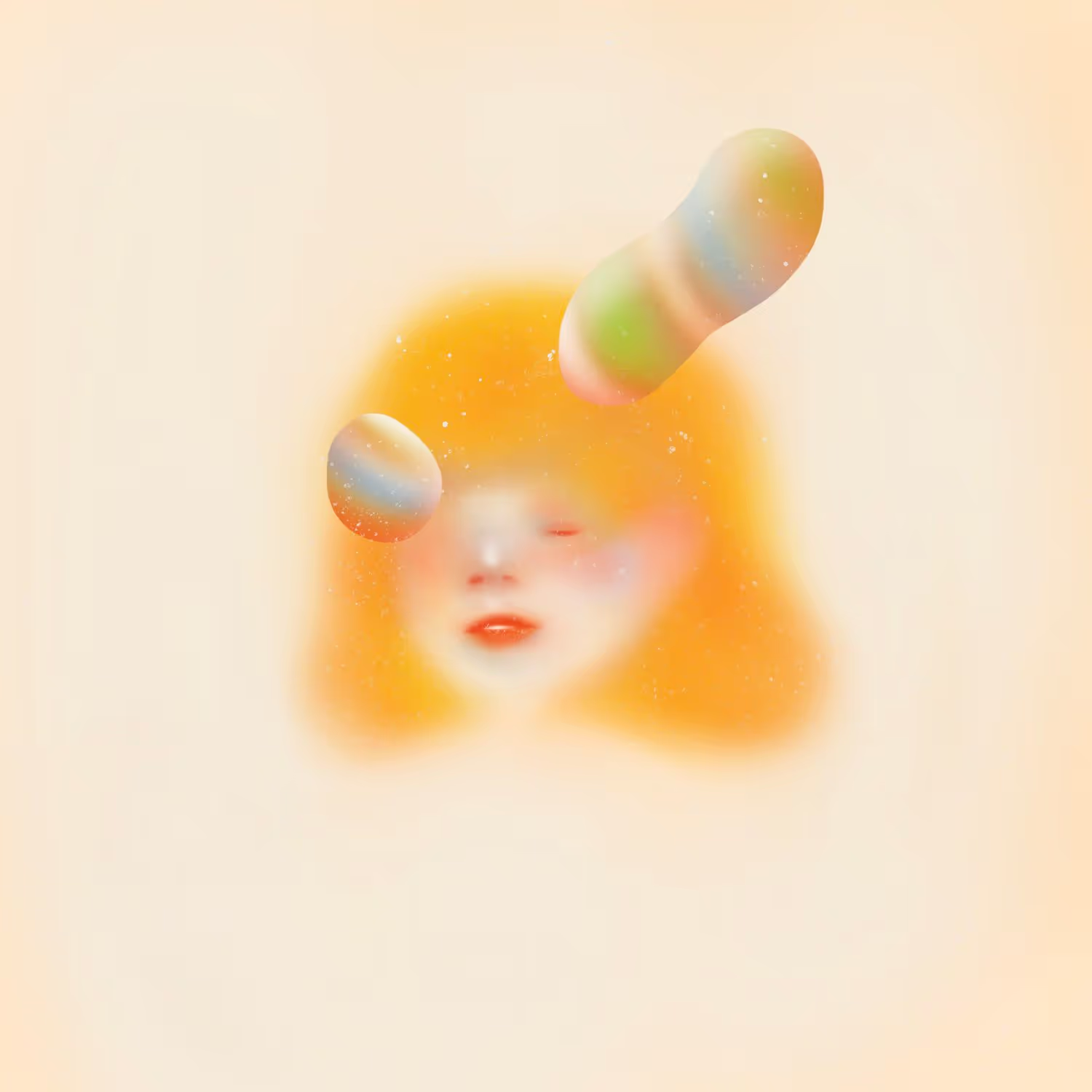
OpenSea: Can you tell us about your artistic background and how you first entered the world of web3 and NFTs?
Seneca: I can’t remember a time when I wasn’t drawing stories or dreaming of a film in my head. I was a very withdrawn kid and was just too concerned with my imagination rather than reality. And yes, I was the token “art kid” of my grade. Boring and obvious! But it made sense.
I went on to be classically trained as an artist and designer at the Rhode Island School of Design, where I emerged as a professional illustrator. While traversing the choppy waters of being a freelancer, I was always developing my personal work along the way.
My work had its first footprint in web3 with the Bored Apes, I’m not kidding. It was that character design collaboration that brought me here.

OpenSea: What is the inspiration behind your new generative art series, "Perils of Sēsē?” Would you say this collection represents a departure or evolution from your previous work?
Seneca: It began with three things. One, I wanted to construct something original in my own voice [that] had something to do with introspection, self-reflection. Two, I wanted to challenge myself to take an abstract concept and create a tangible visual design that accurately captures the essence and feeling of that concept. This led me to take the existing structure of Freud’s theory of the human psyche (Id, Super-Ego, and the Ego) and spin them into characters. Three, I took inspiration from cel animation. The generative aspect of it [comes from] this method of using a singular background and changing out the different elements, characters, and poses that ultimately change the meaning behind every still image.
And I would say it’s all of the above? My paintings look and feel a little different because they have different techniques, but honestly, it’s all cohesive if you can understand brushstrokes and tone. What’s new here is that I’m taking things to a different level than before. I’m trying my hand at world-building.
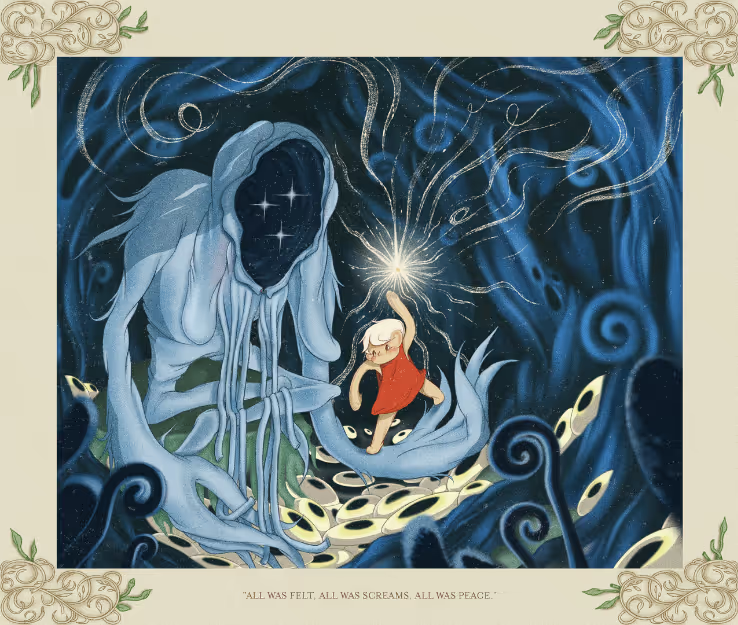
OpenSea: "Perils" used a mix of generative and hand-drawn elements. Can you discuss the balance between these two and how they each contribute to the overall aesthetic and storytelling?
Seneca: It’s all hand-drawn and painted by me. This will always be very important because it’s where my roots are - stemming from traditional illustration and animation. A computer can’t do me better than me.
Where code does play a factor: the mechanism where it takes my art elements and churns and spits them out. I think of it like having a team of 100 animators in a studio working on each frame alongside me directing. This script so cleverly engineered by my talented technical partners does this.
Automation is also a factor here that I had to understand for “Perils.” Was I ready to relinquish some control over the final design in some ways? The randomized outputs have an aspect of fate in them, as well as my curated vision.
Again, I have to credit my partners, Transient Labs. As artists themselves, they understood it completely and knew what needed to be done to execute the idea!
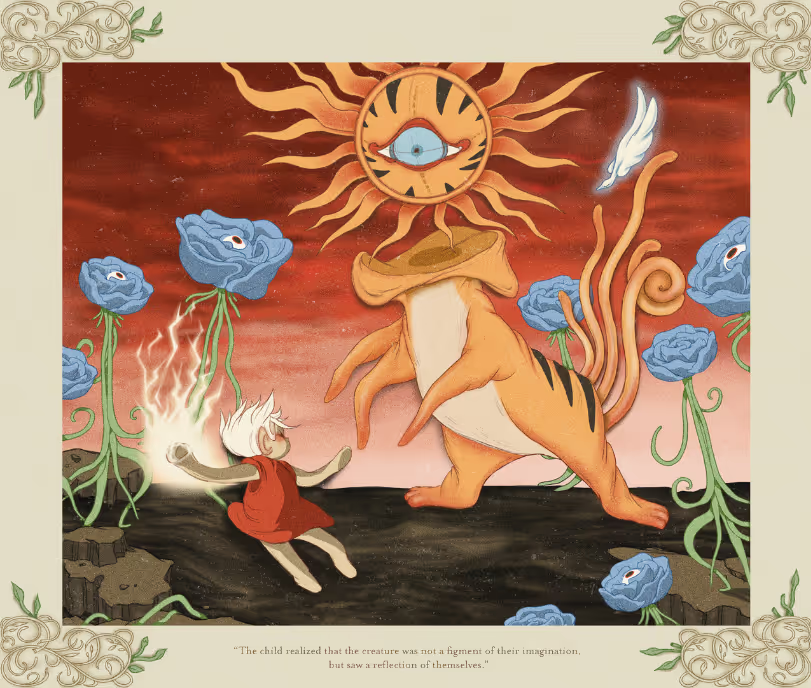
OpenSea: "Perils of Sēsē" is the first collection to utilize Transient Labs' ERC-7160 technology. How has this new standard influenced your creative process, and what possibilities does it unlock for both artists and collectors?
Seneca: I will say I hadn’t realized Transient was working on 7160 till after the fact. We have liked to say our partnership was “serendipitous” - both our goals were met by coming together. They clearly have a mind for storytelling (quite literally with the “Story Inscription” feature, which I will let them speak to their genius behind that.)
Any innovative tool made will continue and challenge creators to take full advantage of it. It could be the tool before artist or artist before the tool - and in this case it’s the latter.
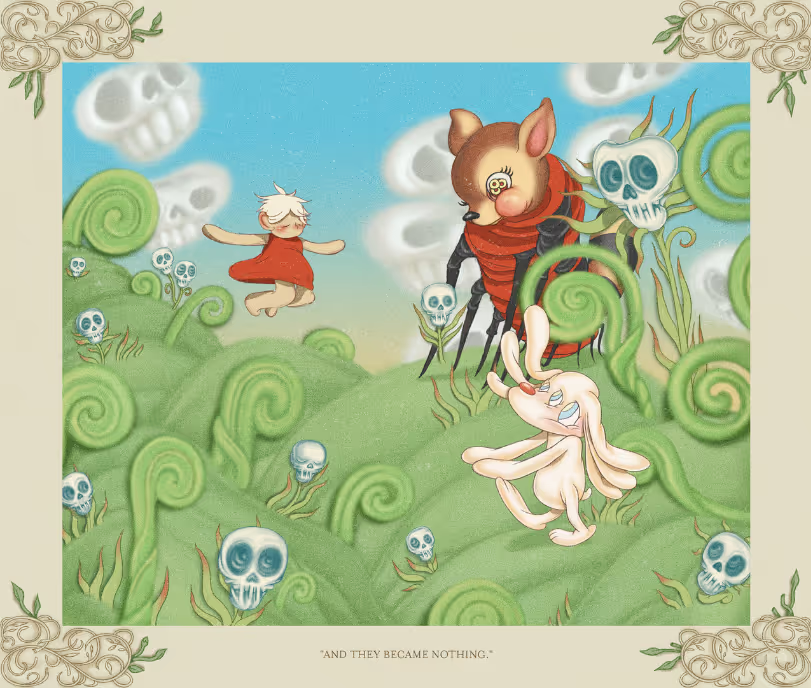
OpenSea: How does the ERC-7160 standard influence the interaction between you as the artist, collectors, and the art itself?
Seneca: With Perils, the intention was to create a story beat that encouraged the viewer to pause in this world of instant gratification and try to connect and see the soul behind the artwork. I wanted to create something interesting at first glance but feel deeper in meaning as you hold it longer. The “evolution” of the art is granted by the new 7160 standard.
OpenSea: You've described "Perils of Sēsē" as a non-linear, multi-chapter abstract story about the reflection of the Self. How does the narrative structure of the series align with the generative nature of the art? What kind of experience do you hope viewers will have as they navigate through the story?
Seneca: It’s inspired by the work of traditional cel animation, where you have a painted background and then transparent cels that have hand-painted figures, poses, and effect elements that are interwoven to speak the story. Like I've mentioned before, the generative script can do this for me as if I had animators working alongside me, but with the spark of automation.
The experience I want people to feel is a preciousness and wonderment. I had begun collecting animation cels when I could first afford it, and it felt truly precious. I had in my hands the frame from the work of art that I loved. It’s out of my control how people felt about my personal artwork, but perhaps this structure would make more sense in people's eyes than it would from a traditional 1/1 painting.
My work might be a little dark, so perhaps they’ll also feel a bit spooked. I always chase capturing the feeling of dread, as I’m inspired by cosmic horror and dreams.

OpenSea: Given your positive experience with ERC-7160 in "Perils of Sēsē," are there any future projects you plan to work on using this innovative token standard?
Seneca: Could be, who knows. If I have something in mind I’m certainly not giving it away now. Anyone who knows me knows that I stay silent till the idea makes sense and is something I can be proud of.
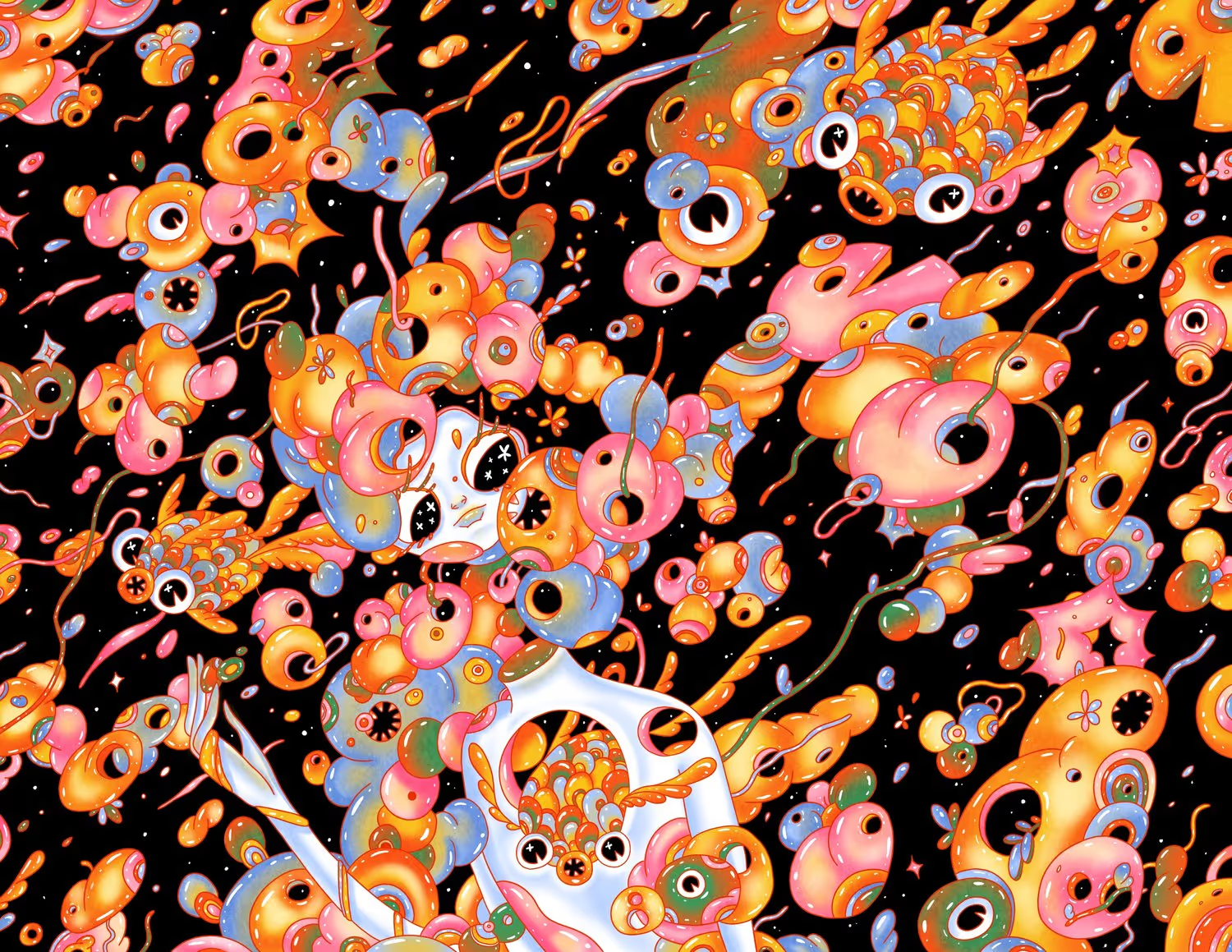
OpenSea: Who or what else excites you in the web3 and NFT space right now?
Seneca: The fact that we’re starting from ground zero. I think I said on a podcast something like, “We’re witnessing the evolution of man. And I’m an amoeba.” Incredible legacy producers, artists, and crazy entrepreneurs are all here working from the ground up. It’s pretty amazing and something I don’t think I would’ve been able to witness in my previous work environment. I love it so much. So much brilliance around me.
OpenSea: As the lead artist behind Bored Ape Yacht Club, your work has had a significant impact on the NFT community. As the ecosystem continues to evolve, what developments or trends are you most excited about, and how do you see them shaping the future of web3 art?
Seneca: Some advice for anyone creating or creative: Don’t follow trends, aim to make them. And the best way to do this is to be authentically yourself. Trust that your true work will find its home, and it probably won’t be what you think it is. Who cares about trends? If I did, I would’ve made a Seneca derivative ape collection in year one.
This may not be the answer you are looking for, but I have zero foresight on what “web3 art” will shape up to be. Will we even call it web3 in a few years? Can we finally settle on calling this stuff “Digital art” instead of “NFT art”? We have zero control over what this culture will become. As artists, we should just focus on each of our experiments and aim to make them as beautiful as we can at the moment.
OpenSea: Can you talk about the motivation behind creating the ERC-7160 token standard and how it addresses existing challenges or limitations in the NFT space?
Marco Peyfuss, co-founder of Transient Labs and co-author of the ERC-7160 standard: We've always been interested in creating ways to use the blockchain as part of the creative/artistic process and have the smart contract code really be a piece of the art. Looking back on our past projects, we think this is super apparent. ERC-7160 is a step forward in this direction where on-chain history is preserved and you can start to tell very compelling and unique stories with the smart contract.
Typically, projects are forced to just change metadata if they want to provide some sort of evolution or storytelling process. This can cause friction with collectors as their token is forcibly changed and there is no way to go back to the previous state. ERC-7160 solves this as the collector has ultimate ownership of the [item] and can choose to display any state that the token has ever held. It also opens the opportunity to tell stories on individual tokens rather than the entire collection at once. This provides for a deeper relationship between creators and collectors.
OpenSea: How does ERC-7160 empower artists, like Seneca, and collectors?
Marco Peyfuss: ERC-7160 empowers both creators and collectors significantly. Creators are empowered to tell never-ending stories with on-chain provenance and immutability. Collectors are empowered to always have the final say on their token metadata. This standard really helps enforce true ownership without limiting creators' vision.
OpenSea: Transient Labs has a dual focus on creativity and technical prowess. How do you see ERC-7160 and other innovations contributing to the intersection of blockchain technology and creative industries?
Marco Peyfuss: We believe that the blockchain can be used as an artistic medium, similar to a paintbrush or generative code. NFTs are the next generation of digital [items] and the creativity you can unlock with the blockchain is limitless. Our mission is to provide creators [with] these innovations without the need to write a single line of code.
Cover photo of artist by Fei Tang (@phives)





.avif)
.png)
.png)
.png)
.png)
.png)


